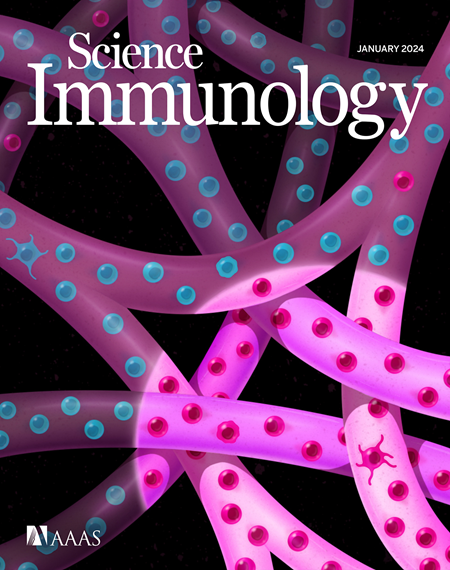造血干细胞异质性和与年龄相关的血小板偏向在进化过程中是保守的。
IF 16.3
1区 医学
Q1 IMMUNOLOGY
引用次数: 0
摘要
造血干细胞(HSCs)在临床骨髓(BM)移植后可重建多系人类造血,也是某些血液恶性肿瘤的起源细胞。虽然造血干细胞可提供多系移植,但单个小鼠造血干细胞具有系偏向性,对血细胞系的贡献不均衡。在这里,我们在小鼠体内进行了高通量单细胞 RNA 测序,在小鼠体内异种移植了分子条码化的成人人类 BM HSCs。我们证明,人类个体的骨髓造血干细胞在功能和转录上也存在血系偏向。具体来说,我们发现了血小板偏向和多系人类造血干细胞。通过定量比较年轻和年老的单个造血干细胞的转录组发现,血小板偏向造血干细胞的比例及其转录血小板引物的水平都会随着年龄的增长而增加。因此,血小板偏向的造血干细胞及其在衰老过程中的增加和转录血小板引物是哺乳动物进化过程中的保守特征。本文章由计算机程序翻译,如有差异,请以英文原文为准。
Hematopoietic stem cell heterogeneity and age-associated platelet bias are evolutionarily conserved
Hematopoietic stem cells (HSCs) reconstitute multilineage human hematopoiesis after clinical bone marrow (BM) transplantation and are the cells of origin of some hematological malignancies. Although HSCs provide multilineage engraftment, individual murine HSCs are lineage biased and contribute unequally to blood cell lineages. Here, we performed high-throughput single-cell RNA sequencing in mice after xenograft with molecularly barcoded adult human BM HSCs. We demonstrated that human individual BM HSCs are also functionally and transcriptionally lineage biased. Specifically, we identified platelet-biased and multilineage human HSCs. Quantitative comparison of transcriptomes from single HSCs from young and aged BM showed that both the proportion of platelet-biased HSCs and their level of transcriptional platelet priming increase with age. Therefore, platelet-biased HSCs and their increased prevalence and transcriptional platelet priming during aging are conserved features of mammalian evolution.
求助全文
通过发布文献求助,成功后即可免费获取论文全文。
去求助
来源期刊

Science Immunology
Immunology and Microbiology-Immunology
CiteScore
32.90
自引率
2.00%
发文量
183
期刊介绍:
Science Immunology is a peer-reviewed journal that publishes original research articles in the field of immunology. The journal encourages the submission of research findings from all areas of immunology, including studies on innate and adaptive immunity, immune cell development and differentiation, immunogenomics, systems immunology, structural immunology, antigen presentation, immunometabolism, and mucosal immunology. Additionally, the journal covers research on immune contributions to health and disease, such as host defense, inflammation, cancer immunology, autoimmunity, allergy, transplantation, and immunodeficiency. Science Immunology maintains the same high-quality standard as other journals in the Science family and aims to facilitate understanding of the immune system by showcasing innovative advances in immunology research from all organisms and model systems, including humans.
 求助内容:
求助内容: 应助结果提醒方式:
应助结果提醒方式:


